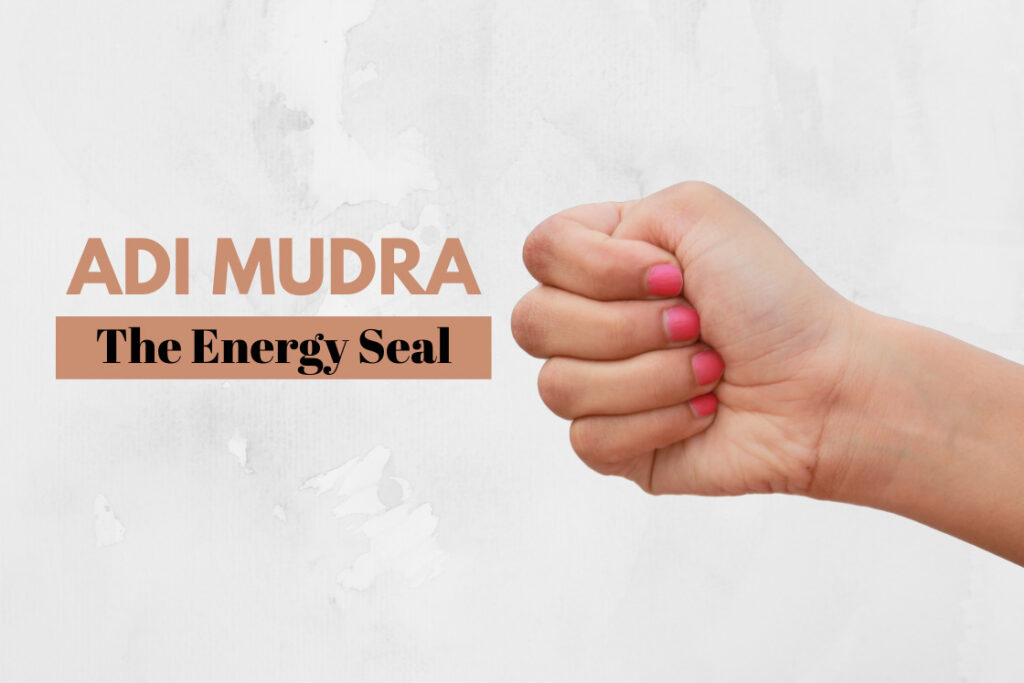Adi Mudra is a sacred hand gesture (mudra) used in yogic and meditative practices to promote inner calm, activate the nervous system, and support respiratory health. Rooted in the ancient traditions of Hatha Yoga, the term “Adi” means first or primordial, and “Mudra” means gesture or seal. Thus, this is often referred to as the “Primordial Gesture”, symbolizing a return to our original, natural state of being.
Table of Contents
Origins and Symbolism:
Adi Mudra is believed to mimic the natural hand position of a fetus in the womb. This gesture represents innocence, introspection, and primal energy. It is traditionally used during pranayama (breath control exercises) and meditation to facilitate a deeper connection to the self and to invoke a sense of safety and inner stillness.
How to Perform Adi Mudra:
Adi Mudra is a simple yet powerful hand gesture that anyone can practice, regardless of experience level. Here’s a step-by-step guide:
Step 1:
Choose a meditative posture such as Sukhasana (Easy Pose), Padmasana (Lotus Pose), or Vajrasana (Thunderbolt Pose). Ensure your spine is straight and your shoulders are relaxed.
Step 2:
Place your hands on your thighs or knees with palms facing upward. Curl your thumbs inward so that they rest inside your palms. Fold your remaining fingers gently over your thumbs to form a soft fist.
Step 3:
Close your eyes and bring awareness to your breath. Inhale and exhale slowly and deeply through the nose. Maintain this mudra for 5–15 minutes, ideally at the beginning or end of a yoga session or meditation.
Benefits Of Adi Mudra:
Adi Mudra exerts a calming effect on the body and mind through its influence on the nervous and respiratory systems. Here are some of its most recognized benefits:
Calms the Nervous System:
This Mudra activates the parasympathetic nervous system, which helps reduce stress, anxiety, and tension. It is particularly helpful during meditation or before sleep.
Enhances Lung Capacity:
By encouraging diaphragmatic breathing, this Mudra supports fuller, more efficient breathing. This is beneficial for individuals with shallow breath patterns or respiratory issues.
Promotes Mental Clarity:
This mudra aids in mental focus, grounding, and clarity, making it ideal for meditative practices and spiritual contemplation.
Stimulates the Brain:
This Mudra is believed to increase the flow of oxygen to the brain, thereby enhancing cognitive functions such as memory, alertness, and concentration.
Balances Prana (Vital Energy):
In yogic philosophy, Adi Mudra helps regulate the flow of prana (life force energy) throughout the body, aligning and balancing the energy centers or chakras.
When and How Often to Practice Adi Mudra:
Adi Mudra can be practiced:
- During meditation for enhanced focus.
- Before sleep to calm the mind and body.
- During pranayama sessions to deepen the breath.
- In stressful situations to promote instant relaxation.
It is generally safe to practice Adi Mudra for 5 to 15 minutes, one to three times a day.
Precautions and Contraindications:
While Adi Mudra is safe for most people, here are some things to consider:
- Individuals with hand injuries or arthritis should avoid strain and consult a therapist or yoga instructor before practicing.
- Maintain relaxed pressure in the hands. Do not squeeze the fingers tightly around the thumb.
- If you experience dizziness or discomfort, discontinue and resume normal breathing.
Conclusion:
Adi Mudra is a subtle yet profound gesture that reconnects us with our most primal state of calm, security, and presence. It acts as a gateway to inner stillness and is a beautiful addition to any meditation or pranayama routine. Whether you are a seasoned yogi or a beginner, incorporating this Mudra into your daily practice can bring about a transformative sense of peace and balance.
FAQ:
Q. What is Adi Mudra used for?
A. Adi Mudra is primarily used to calm the nervous system, support deep breathing, and promote mental clarity. It’s a grounding gesture often practiced during meditation and pranayama to enhance focus and inner peace.
Q. Can beginners practice Adi Mudra?
A. Yes, Adi Mudra is simple and safe for beginners. It does not require any advanced flexibility or yoga experience and can be incorporated easily into a daily meditation or breathwork routine.
Q. How long should I hold Adi Mudra?
A. You can hold this Mudra for 5 to 15 minutes per session. It can be practiced multiple times a day, especially during meditation, before sleep, or during breathing exercises.
Q. Is there a best time of day to practice Adi Mudra?
A. While it can be practiced at any time, early morning or before bedtime are especially beneficial. Practicing before sleep can promote relaxation and help manage insomnia or restlessness.
Q. Can I do Adi Mudra while lying down?
A. Yes, this Mudra can be performed while lying down, especially for relaxation or sleep. However, it’s most effective in a seated meditation posture with a straight spine.
Q. Can Adi Mudra help with anxiety?
A. Yes. this Mudra activates the parasympathetic nervous system, which helps reduce anxiety and stress. Practicing it with slow, conscious breathing amplifies its calming effects.
Q. Is Adi Mudra associated with any chakras?
A. This Mudra is often associated with the throat (Vishuddha) and heart (Anahata) chakras, promoting communication, calmness, and emotional balance.
Q. Are there any side effects of practicing Adi Mudra?
A. There are no known negative side effects when done correctly. However, those with hand pain or injuries should avoid straining their fingers and may consult a yoga therapist if unsure.
Q. Can Adi Mudra be combined with breathing exercises (pranayama)?
A. Absolutely. this Mudra is especially effective when combined with pranayama techniques such as Ujjayi, Nadi Shodhana, or deep diaphragmatic breathing, as it enhances breath control and awareness.





